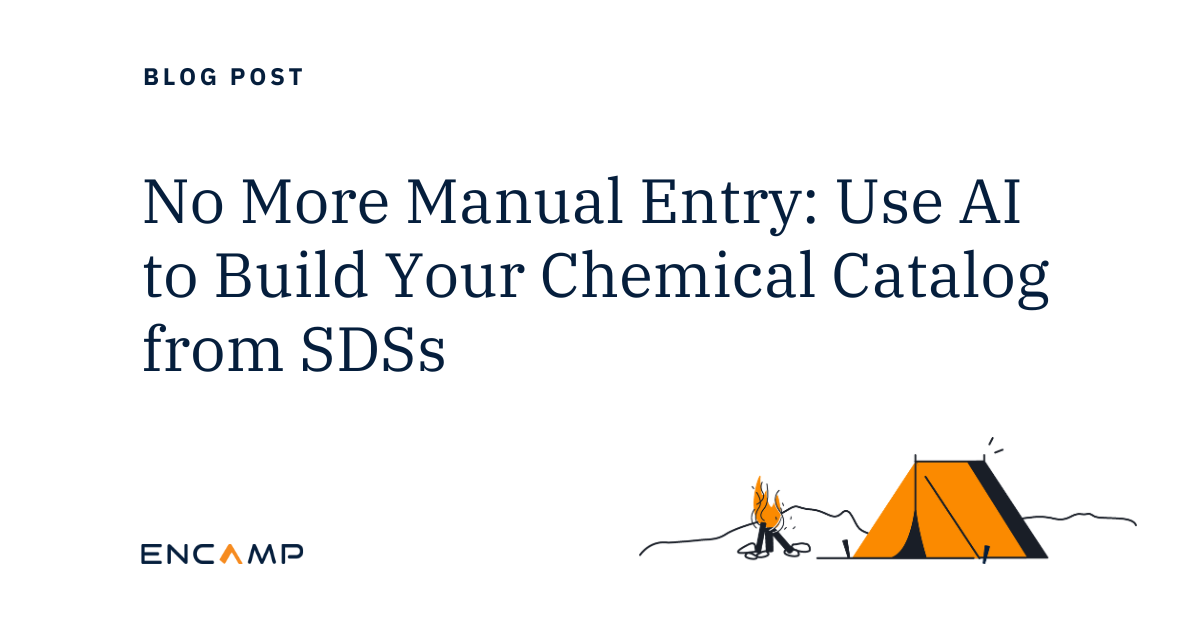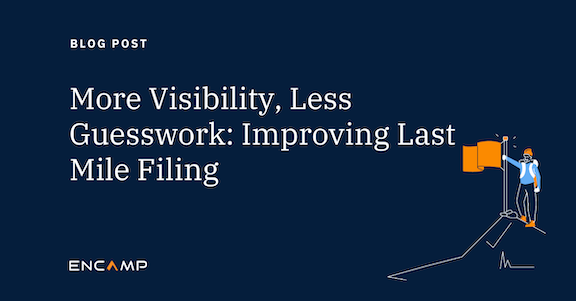The details of EPCRA Tier II reporting can get murky. And often confusing. Encamp’s VP of Compliance and Customer Success breaks down the key aspects EPCRA Tier II reporting requirements here to help your business comply with total confidence.
Who must file Tier II reports?
On the federal level, any regulated facility in the U.S. that stores or handles more than 10,000 pounds of hazardous chemicals must submit an annual Tier II inventory report. Facilities storing or handling an Extremely Hazardous Substance (EHS) of 500 pounds or its threshold planning quantity (TPQ, whichever is lower) are also required to submit the annual Tier II inventory.
As defined by the EPA, hazardous chemicals are “substances for which a facility must maintain a Safety Data Sheet (SDS) under the Occupational Safety and Health Administration (OSHA) Hazard Communication Standard.” This standard establishes the criteria used to identify a hazardous chemical. OSHA defines a hazardous chemical as any chemical that can “cause a physical or health hazard.” Common chemicals that many facilities store on-site, such as antifreeze, ethanol, diesel fuel, and propane, are subject to this reporting.
EHSs can be tricky
While EHSs have a general threshold of 500 pounds, thresholds can be lower for specific substances dependent on the TPQ published for the chemical. TPQs are based on “acute mammalian toxicity and potential for airborne dispersion and represent those quantities of substances that can cause significant harm should an accidental release occur.” See the list of EHSs and their corresponding TPQs in Appendix A of the EPA’s List of Lists. There are many common chemicals considered to be EHSs that might surprise you. Examples include anhydrous ammonia, sulfuric acid, formaldehyde, and hydrogen peroxide (if the concentration is over 52%).
Retail gas and diesel stations share a common EHS threshold exemption. Higher thresholds apply for retail gas and diesel stations if their fuel storage tanks are located entirely underground, and if the tanks are in compliance with all applicable underground storage tank (UST) requirements set by the federal, state, and local government. For a retail gas station, the threshold for gasoline is 75,000 gallons and the threshold for diesel is 100,000 gallons. (Read more on exemptions and relaxed thresholds in our associated blog on Hazardous Chemical Inventories.)
How to comply with EPCRA Tier II Reporting
Based on the EPCRA Tier II reporting requirements we’ve detailed thus far, you’ve determined that your facility is required to report under EPCRA. So what’s the next step?
Under Section 311 of EPCRA, for hazardous chemicals stored onsite at or above the thresholds, facilities must submit SDSs to their State Emergency Response Commission (SERC), Local Emergency Planning Committees (LEPCs), and local fire department. Unless your state or local government determines otherwise, submitting an SDS for a hazardous chemical is required just once; thereafter, SDSs are required only for new chemicals stored or handled at a facility.
Submitting an EPCRA Tier II form
On an annual basis, regulated facilities are required to submit an inventory of the chemicals that meet the definition of a hazardous chemical and exceed the defined reporting threshold. By law, EPCRA Tier II forms are due on March 1 each year.
Of note, while the EPA has published a generic EPCRA Tier II form to submit inventory reports, each state in the U.S. has developed its own version of the form. Some states naturally require state-specific EPCRA Tier II reporting requirements on their form. They also require the information to be submitted online through the state’s own portal or via email. Otherwise, the EPA and state agencies request the same core information for EPCRA Tier II reporting, including facility information (address, NAICS code, number of occupants, etc.) and contact information (emergency contact, owner/operator contact, and Tier II contact).
In addition to general facility information, Tier II forms also sometimes request other facility specific questions. For example, if your facility is subject to the Risk Management Program (RMP) through the EPA, you’ll need to indicate that and provide your facility’s RMP ID#.
Chemical inventory information
The chemical inventory section of an EPCRA Tier II form is much more detailed. To ensure compliance, you must provide the following information on the hazardous chemicals you’re reporting:
- Physical state (liquid, solid, gas)
- Is it pure or in a mixture?
- CAS# (if applicable)
- Whether the chemical is an EHS or contains an EHS
- The maximum amount on-site on any given day
- The average amount on-site per day
- The physical and health hazards associated with the chemical
- The locations of chemicals on-site
Several states request more information beyond these requirements. For example, Maine requires the mode of shipment for a hazardous chemical, the frequency of shipment, maximum capacity per single vessel, average shipment quantity, and other shipping criteria. In another example, Ohio requests the total number of EHS and hazardous chemicals to be included in its EPCRA Tier II report.
Facility site plans
Along with the chemical inventory information, some states additionally require you to submit facility site plans. Such plans show where chemicals are stored in the facility, and where emergency exits, fire extinguishers, and nearest water source are located. Site plans are crucial for first responders who need to know these details before they enter a facility in an emergency situation. Check with your state to see if a facility plan is required as part of your EPCRA Tier II submission, what needs to be on the plan, and the file format it should be in.
Fees
Once required Tier II reporting information and documents are uploaded to a state’s reporting portal, several states require facilities to pay a filing fee per report. Fee amounts vary based on a state’s criteria. For instance, states including Louisiana, Minnesota, and Pennsylvania bill your facility per each chemical being reported. Other states, like New Jersey, bill the facility by the number of employees. Many state portals accept payment of the fees directly, whereas other states send your facility a bill and require you to pay by check or credit card. Depending on your state, the LEPCs may charge fees as well.
Due date for EPCRA Tier II submissions
Frequently Asked Question: when is all this Tier II information and documentation due? Again, the annual Tier II report is due March 1 each year, which is the deadline set federally. All 50 states follow this deadline except for specific jurisdictions in California. California is divided into Certified Unified Program Agencies, or CUPAs for short. Some CUPAs require this information to be submitted at different times during the year. Also in New Jersey, public and private entities have different due dates. For the most part, states require the information before March 1. If your information is submitted late or not submitted at all, you could be subject to enforcement actions, fines, or both.
Proactive environmental compliance for EPCRA
Tier II reporting preparations for EPCRA compliance are a year-round activity. Or at least they should be to avoid the risk of non-compliance, which can result in costly penalties and a tarnished reputation for your business. With our end-to-end platform for environmental compliance, Encamp lets you proactively manage the risk of non-compliance as well as error-prone manual processes to prepare and submit Tier reports.
Transforming the way enterprises stay in compliance
Encamp is on a mission to create a world where good for business can equal good for the environment. We help enterprises transform compliance programs and human processes into a technology-driven system that lays the foundation for accurate and ongoing environmental compliance through a blended method of intelligent high-tech solutions and high-touch expert support.
Megan Walters
Megan is Encamp’s VP of Compliance & Customer Success and formerly a Senior Environmental Scientist. But she’s also a Certified Environmental and Safety Compliance Officer® (CESCO), an EHSMS Internal Auditor, a Certified Hazardous Materials Manager, eRailSafe certified, a HAZWOPER 40 Hour - Emergency Response Technician, and skilled in RCRA, DOT, and ISO 14001. Obviously, she knows “compliance.”



